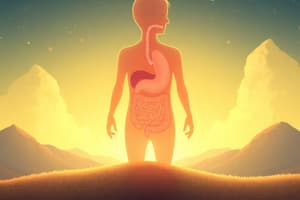Podcast
Questions and Answers
Which of the following is the most prominent deficiency in global malabsorption?
Which of the following is the most prominent deficiency in global malabsorption?
- Vitamin B12
- Folic acid (correct)
- Vitamin D
- Iron
Bile acid diarrhea is also known as cholera.
Bile acid diarrhea is also known as cholera.
True (A)
What is the daily dosage of folic acid recommended for treatment in cases of global malabsorption?
What is the daily dosage of folic acid recommended for treatment in cases of global malabsorption?
5mg
In global malabsorption, stool examination is performed to rule out ______.
In global malabsorption, stool examination is performed to rule out ______.
Match the following clinical features with their descriptions:
Match the following clinical features with their descriptions:
What is a common symptom of malabsorption related to bacteria in the lumen?
What is a common symptom of malabsorption related to bacteria in the lumen?
Vitamin K deficiency is prominent in Tropical Sprue.
Vitamin K deficiency is prominent in Tropical Sprue.
What is the gold standard for investigating bacterial overgrowth in the small intestine?
What is the gold standard for investigating bacterial overgrowth in the small intestine?
The first-line antibiotic for bacterial overgrowth is __________.
The first-line antibiotic for bacterial overgrowth is __________.
Match the following deficiencies with their associated conditions:
Match the following deficiencies with their associated conditions:
What characterizes bile acid diarrhea?
What characterizes bile acid diarrhea?
Fatty acid diarrhea is associated with increased bile acid absorption.
Fatty acid diarrhea is associated with increased bile acid absorption.
What is the primary condition leading to short bowel syndrome in adults?
What is the primary condition leading to short bowel syndrome in adults?
Short bowel syndrome is diagnosed when the length of the small intestine (SI) is less than ______ cm.
Short bowel syndrome is diagnosed when the length of the small intestine (SI) is less than ______ cm.
Match the types of diarrhea with their characteristics:
Match the types of diarrhea with their characteristics:
Which antibody type is most crucial for the diagnosis and monitoring of global malabsorption?
Which antibody type is most crucial for the diagnosis and monitoring of global malabsorption?
The Anti-Endomysial antibody has a poor sensitivity of 73%.
The Anti-Endomysial antibody has a poor sensitivity of 73%.
What is the feature of the mucosal biopsy findings indicative of global malabsorption?
What is the feature of the mucosal biopsy findings indicative of global malabsorption?
The ______________ is a scoring system associated with the diagnosis of malabsorption.
The ______________ is a scoring system associated with the diagnosis of malabsorption.
Match the serology tests with their specific features:
Match the serology tests with their specific features:
What is one of the deficiencies caused by the absence of the jejunum?
What is one of the deficiencies caused by the absence of the jejunum?
SIBO is primarily caused by the absence of the ileocecal valve.
SIBO is primarily caused by the absence of the ileocecal valve.
What is the recommended protein intake for a patient with a present colon?
What is the recommended protein intake for a patient with a present colon?
Which condition is most commonly associated with the complications of refractory celiac disease?
Which condition is most commonly associated with the complications of refractory celiac disease?
In the proximal small intestine, there are __________ present.
In the proximal small intestine, there are __________ present.
Match the following conditions with their related symptoms:
Match the following conditions with their related symptoms:
Whipple's disease primarily affects females over males.
Whipple's disease primarily affects females over males.
What dietary components are recommended for the treatment of celiac disease?
What dietary components are recommended for the treatment of celiac disease?
The gram-positive actinobacterium responsible for Whipple's disease is called ______.
The gram-positive actinobacterium responsible for Whipple's disease is called ______.
Match the following diseases with their diagnostic techniques:
Match the following diseases with their diagnostic techniques:
What is the most consistent gastrointestinal symptom of Whipple's disease?
What is the most consistent gastrointestinal symptom of Whipple's disease?
Oculofacial myorhythmia is a neurological manifestation of Whipple's disease.
Oculofacial myorhythmia is a neurological manifestation of Whipple's disease.
What condition can lead to weight loss, diarrhea, and abdominal pain in Whipple's disease?
What condition can lead to weight loss, diarrhea, and abdominal pain in Whipple's disease?
The predominant joint symptom in Whipple's disease is __________.
The predominant joint symptom in Whipple's disease is __________.
Match the following cardiovascular complications with their descriptions:
Match the following cardiovascular complications with their descriptions:
What clinical feature is caused by impaired carbohydrate digestion in the small intestine leading to excessive fermentation in the colon?
What clinical feature is caused by impaired carbohydrate digestion in the small intestine leading to excessive fermentation in the colon?
Hyperoxaluria occurs due to excessive absorption of calcium in the intestines.
Hyperoxaluria occurs due to excessive absorption of calcium in the intestines.
What condition is characterized by low magnesium absorption from the ileum?
What condition is characterized by low magnesium absorption from the ileum?
The absence of the ileum results in reduced absorption of bile acids and vitamin ______.
The absence of the ileum results in reduced absorption of bile acids and vitamin ______.
Match each clinical feature of global malabsorption with its corresponding condition:
Match each clinical feature of global malabsorption with its corresponding condition:
Which of the following are entities included in inflammatory bowel disease?
Which of the following are entities included in inflammatory bowel disease?
Microscopic colitis is characterized by bloody diarrhea.
Microscopic colitis is characterized by bloody diarrhea.
What are the two patterns seen in biopsy for microscopic colitis?
What are the two patterns seen in biopsy for microscopic colitis?
Diversion colitis is seen in patients using __________ bags after surgery for bowel malignancies.
Diversion colitis is seen in patients using __________ bags after surgery for bowel malignancies.
Match the following features with the types of colitis:
Match the following features with the types of colitis:
What is considered the best treatment regimen for the induction phase of Tropical Sprue?
What is considered the best treatment regimen for the induction phase of Tropical Sprue?
Tropical Sprue affects the small intestine with a pan-intestinal involvement lasting 2-3 weeks.
Tropical Sprue affects the small intestine with a pan-intestinal involvement lasting 2-3 weeks.
What is the drug of choice for the maintenance treatment of Tropical Sprue?
What is the drug of choice for the maintenance treatment of Tropical Sprue?
The major fermentation product associated with the pathogenesis of Tropical Sprue is ______.
The major fermentation product associated with the pathogenesis of Tropical Sprue is ______.
Match the following treatment phases with their characteristics:
Match the following treatment phases with their characteristics:
Flashcards are hidden until you start studying
Study Notes
Global Malabsorption
- This is a condition that affects the small intestine, leading to decreased absorption of nutrients.
- It is characterized by watery diarrhea, steatorrhea (fat in stool), weight loss, and deficiencies in nutrients like folic acid and vitamin B12.
- Investigations may include biopsies to rule out celiac disease and stool examination to rule out giardiasis.
- Treatment involves increasing the intake of folic acid and using tetracycline.
- Some cases (20%) might relapse.
- In cases of small intestinal bacterial overgrowth (SIBO), bacteria compete for folic acid.
- Treatment may take 3-6 months.
Bile Acid Diarrhea
- Occurs due to defective FGF-19 which regulates bile acid release from the liver.
- Defective FGF-19 leads to increased bile acid release, which causes diarrhea.
- It is seen in tropical sprue.
- It doesn't cause steatorrhea or malabsorption.
Fatty Acid Diarrhea
- Occurs due to severe ileal disease, leading to reduced absorption of bile acids and fat.
- In the colon, fatty acids cause steatorrhea.
- Steatorrhea is defined as > 20g of fat in stool.
- It is characterized by increased ileal bile acid absorption, decreased fecal bile acid excretion, and a decrease in the bile acid pool size.
Limited Ileal Disease
- Any ileal disease produces some FGF-19, but it is not enough. In this case, the liver compensates by producing excess bile acid.
- Bile acid can remove sodium, chloride, and potassium from the intestinal epithelium, leading to diarrhea.
- Limited ileal disease does not cause steatorrhea or malabsorption.
Short Bowel Syndrome
- Defined as < 200 cm length of the small intestine (SI).
- Very severe short bowel syndrome is defined as < 100 cm length of the SI.
- Most common etiologies in adults include mesenteric vascular disease, resections, and Crohn's disease.
- Most common etiologies in children include necrotizing enterocolitis.
Small Intestinal Bacterial Overgrowth (SIBO)
- SIBO occurs when bacteria in the small intestine become overpopulated.
- This can be caused by anatomical defects, functional motility disorders (e.g., IBS), or other conditions like scleroderma and diabetes.
- SIBO can lead to various complications, including hyperoxaluria, cholesterol gallstones, D-lactic acidosis, hypergastrinemia, hypomagnesemia, and increased gastric emptying.
- Treatment includes antibiotics, such as rifaximin, to control bacterial growth.
Tropical Sprue
- Tropical sprue is a malabsorption condition prevalent in regions like India, Bangladesh, and Pakistan.
- It presents with features similar to celiac disease, including intestinal damage and impaired absorption.
- This is a condition that primarily affects the small intestine and causes malabsorption of multiple nutrients.
- Typically, there is a history of an infectious diarrhea episode before the onset of malabsorption symptoms.
- Treatment includes antibiotics like ceftriaxone or meropenem for induction and co-trimoxazole for maintenance, as it prevents relapse and has good CNS penetration.
- Microscopic features show PAS-positive foamy macrophages in the epithelium, lamina propria, and submucosa, as well as enlarged villi.
Celiac Disease
- This is an autoimmune disorder triggered by gluten consumption.
- It causes damage to the small intestine, leading to malabsorption.
- Serology tests, including anti-TTG, anti-endomysial, and anti-deamidated glutamine dipeptide antibodies, are used for diagnosis.
- Biopsy findings show characteristic changes such as total villous atrophy, crypt hyperplasia, lymphocytic infiltrates, and vascular degeneration of surface epithelium.
- Complications include refractory celiac disease and increased risk for certain cancers, such as enteropathy-associated T-cell lymphoma, small intestinal adenocarcinoma, and esophageal squamous cell carcinoma.
- Treatment involves a gluten-free diet and steroids for refractory cases.
Whipple's Disease
- This is a rare multisystemic infection caused by the bacterium Tropheryma whipplei.
- It can affect multiple organs, including joints, gut, central nervous system, and cardiovascular system.
- The most common symptom is joint involvement, particularly large joints like the knees.
- Neuro-Whipple's is a complication that can lead to rapidly progressive dementia.
- Diagnosis is usually made by biopsy.
Inflammatory Bowel Disease (IBD)
- IBD is a group of chronic inflammatory conditions that affect the digestive tract.
- The two main forms of IBD are ulcerative colitis (UC) and Crohn's disease (CD).
- Microscopic colitis, although sometimes considered an IBD variant, is characterized by chronic watery diarrhea.
- Diversion colitis is a form of colitis that occurs in patients with colostomy bags.
Studying That Suits You
Use AI to generate personalized quizzes and flashcards to suit your learning preferences.




